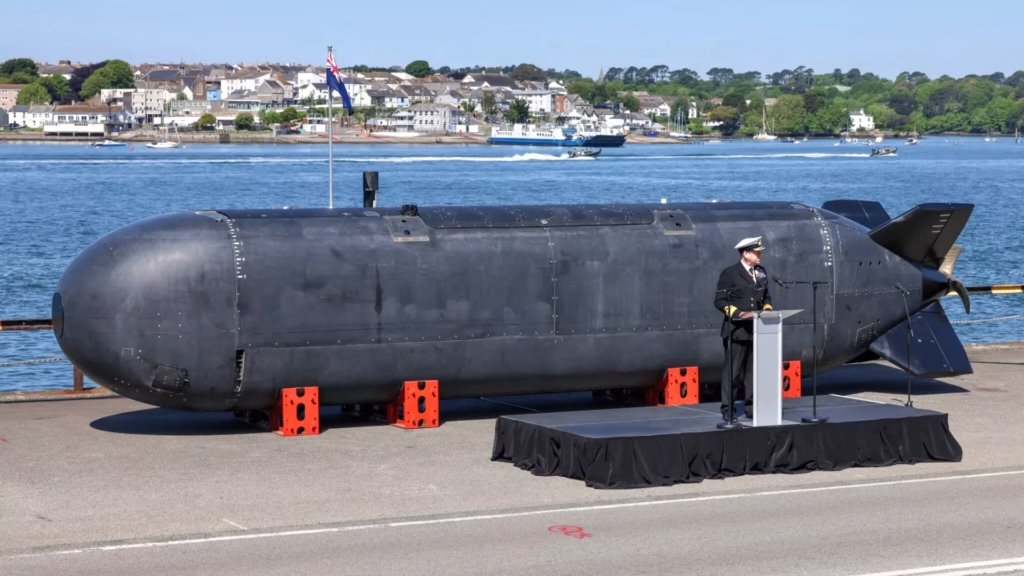
When you picture a Royal Navy submarine, you probably imagine something huge, silent, and cruising deep beneath the ocean with a crew on board. But the future might look very different. Meet the XV-Excalibur, a new robotic submarine that could completely change how underwater missions are done.
It’s part of Project Cetus, an ambitious plan to explore how large, crewless submarines can work alongside traditional nuclear attack subs. And the most exciting part? This futuristic machine was controlled from 10,000 miles away in Australia while it patrolled the waters near Plymouth, England.
This isn’t science fiction. The trial happened at HMNB Devonport, and it’s giving the Royal Navy — and their allies — a glimpse of what naval warfare might look like in the coming decades.
Built by Plymouth-based MSubs, the XV-Excalibur is an Extra-Large Uncrewed Underwater Vessel (XLUUV). That’s a fancy way of saying it’s a big submarine with no crew at all, designed to handle dangerous, long, and complex missions without risking human lives.
Why XV-Excalibur Matters
You might be wondering why the Navy would want submarines without crews. The answer is simple: safety, efficiency, and flexibility. With no humans on board, the entire interior of the vessel can be packed with equipment, sensors, and payloads for different missions. There’s no need for food, air supplies, or living quarters. That means more room for technology.
Even though the Excalibur is smaller than traditional nuclear subs — it’s about the same size as the midget submarines used by the Royal Navy in World War II — it’s loaded with advanced systems. It’s 39 feet long, 7 feet wide, and weighs about 19 tonnes. Details about its speed, range, and propulsion are classified, but what’s known is that it’s one of the most advanced uncrewed subs in all of Europe.
This prototype is currently a test platform, so it doesn’t carry weapons. But its real mission right now is to figure out how robotic submarines can help with anti-submarine warfare, seabed warfare, and intelligence gathering. Think of it as the Navy’s high-tech scout, slipping silently under the waves to collect information or keep watch.
Testing the Future
In July 2025, the XV-Excalibur took part in a major international exercise. It wasn’t just any test — this was part of the UK/US/Australia Maritime Big Play exercise during the huge military event known as Exercise Talisman Sabre. Nineteen nations joined in, including Australia, Canada, France, Germany, India, Japan, and the United States, with several others observing. It’s one of the biggest gatherings of naval power in the world, and Excalibur was right in the middle of it.
One of the highlights of the test was that the submarine was operated from Australia while being thousands of miles away in the UK. This showed that modern communication technology can guide a submarine from the other side of the planet. That’s a big deal for future naval operations, where flexibility and remote control could mean safer and faster missions.
Part of a Bigger Plan
The Excalibur isn’t just a one-off experiment. It’s part of something much larger — both in terms of technology sharing and strategic planning. Project Cetus connects directly with the AUKUS partnership between the UK, US, and Australia. This agreement, known as AUKUS Pillar II, focuses on sharing advanced submarine technologies and helping Australia develop its own fleet of nuclear-powered AUKUS Class attack submarines.
By testing systems like the Excalibur, these countries can figure out the best ways to integrate robotic subs into their fleets. This could make future submarines more versatile, more efficient, and more capable of working together across vast distances.
A Small Submarine with Big Potential
At first glance, you might think the XV-Excalibur is too small to make a big impact. But size isn’t everything in the world of submarines. Its compact form makes it harder to detect, and with no crew to protect, it can go into riskier situations. It can spend more time underwater, operate in areas too dangerous for manned vessels, and carry specialized equipment for different types of missions.
Imagine a fleet of these uncrewed submarines working alongside traditional nuclear-powered ones. The robotic subs could handle surveillance, mine detection, or even shadow enemy vessels, freeing up the crewed submarines for more critical missions. This combination could make navies much more adaptable in the future.
What Comes Next
The XV-Excalibur is just the start. Over its two-year testing program, it will help the Royal Navy figure out how to make robotic subs a regular part of their operations. Engineers and commanders will learn how to control it over long distances, how to swap out its payloads for different missions, and how to keep it hidden from enemy sensors.
If these tests go well, we could see more of these vessels in the coming years — not just in the UK but across allied navies. They might be used to patrol vast stretches of ocean, guard undersea cables, or monitor areas of strategic interest. And because they don’t need a crew, they can stay at sea for much longer without returning to port.
A Glimpse of Tomorrow’s Navy
Looking at the XV-Excalibur, you can’t help but feel like you’re seeing the early days of a major shift in naval technology. Just as drones have transformed air warfare, robotic submarines could transform how we operate under the sea. They promise safer missions, more flexibility, and new ways to keep control of the world’s oceans.
For now, the Excalibur is still a prototype, learning its role and proving its worth. But if history has taught us anything, today’s experimental craft often become tomorrow’s standard equipment. In a decade or two, we might look back at these early trials as the moment the future of naval warfare truly began.
Source: Royal Navy

